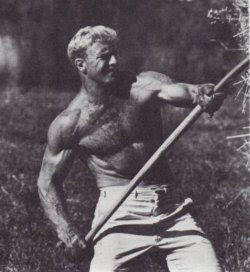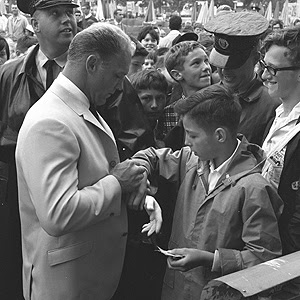CCM and the Golden Jet Take Flight 1968 - 1972
Growing up my favourite hockey player was Bobby Hull. Despite living in a household full of Bruins fans, the sight of him winding up behind his own net for an end-to-end rush inevitably started my heart pounding and brought me to my feet.
My first girlfriend once told me I had shhh'd her mother when Hull was in full flight on the family TV. Her annoyance with me for doing so undoubtedly led to the demise of our relationship. C'mon, I said, it was Bobby Hull for god sakes.

A well-known photo of Hull pitching hay
on his farm just outside of Belleville, ON.
Throughout the sixties no player in the NHL was more recognizable or more feared than Bobby Hull. Hailing from Point Anne, ON, just down the road from my hometown of Kingston, the muscular Hull became known as the “Golden Jet,” hockey's marquee player. With most Canadian homes now having a television set, nothing filled the screen on a Saturday night with more excitement than Hull with his blinding speed, blond hair and blistering shot.
In the latter part of the sixties when CCM looked to launch its new line of medium-priced skates and hockey equipment, company president Tom Nease knew he needed to connect the product to a name and face instantly recognizable by Canadian youngsters. He knew exactly whose face it should be.
 No one drew a crowd on or off the ice like the Chicago star. While Blackhawk owner Bill Wirtz called Hull “the greatest public relations man the NHL ever had,” Time magazine maintained "the sight of Robert Marvin Hull...leaning into a hockey puck to be one of the true spectacles of sport- like watching Mickey Mantle clear the roof, or Wilt Chamberlain flick in a basket or Bart Starr throw that beautiful bomb.”(1)
No one drew a crowd on or off the ice like the Chicago star. While Blackhawk owner Bill Wirtz called Hull “the greatest public relations man the NHL ever had,” Time magazine maintained "the sight of Robert Marvin Hull...leaning into a hockey puck to be one of the true spectacles of sport- like watching Mickey Mantle clear the roof, or Wilt Chamberlain flick in a basket or Bart Starr throw that beautiful bomb.”(1)
Hull's popularity was seen by Nease as the answer to a longstanding question at CCM - how to expand the company's share of the youth market. Despite the stellar reputation of the CCM Tacks, the Tack was an expensive skate and for that reason alone many parents were reluctant to buy them knowing their youngsters would quickly outgrow them. Nease was right. The launch of the Bobby Hull line, marked with Hull's familiar signature, brought CCM instant market appeal at a level where the company had previously struggled.

Such success, however, came with a price. When Tom Nease and Hull's agent met in 1968 to hammer out an agreement between the player and the company, the ensuing contract paid the hockey star $25,000 a year for five years. At a time when endorsement deals were relatively rare, one for $125,000 was simply unheard of.
Advertised as “the greatest name in hockey joins the greatest name in hockey equipment,” the deal was defended by Nease based on its scope. Not only could CCM use Hull’s name and photograph to promote its bicycles and hockey equipment, Hull was committed to making six personal appearances annually on behalf of the company at conventions and trade shows.
Hull, who endorsed everything from Ford cars to Jantzen swimwear, paid little heed to the naysayers who claimed he devoted too much time to his off-ice concerns. When he arrived to sign the CCM contract, Hull used his well-known charm to tell reporters: “I’m going to read this little script. I haven’t had time to memorize it.” (2)
It wasn’t just the money that brought Hull to CCM. He'd been using their skates for some time. In fact, he'd been using them ever since CCM's George Parsons discovered Hull had been cutting the back seam out of his previous skates for added comfort. On catching wind of this Parsons approached the design department at CCM and asked if they could develop a custom-fitting skate with the seam moved to the side. Hull tried it and liked it. Buoyed by this success, the company gambled on him feeling the same way about their hockey sticks.

Although he agreed to give up his Northland Pro for a CCM Custom Pro, Hull maintained an escape clause which allowed him to return to his previous brand of stick, if he could demonstrate that it was "vital to the performance of his work.” (3)
Meanwhile Hull's coach, Billy Reay, was concerned about the cost of the stick. “I hope Bobby put a clause in the contract that says the company (CCM) has to supply him with sticks. You have no idea the number of requests we get for one of Hull’s sticks. It must run into a pile of money,” said Reay at the time. (4)
Even Hull’s team mates benefited from the CCM deal. Whenever the company used Hull’s picture in their promotional material with the club insignia or the Blackhawk name showing, a percentage of the fee was paid to the hockey club for distribution among the other players.

In the end CCM's contract with Hull was not renewed, for while it had landed the Golden Jet on the cover of Time, it had landed Tom Nease in a lot of hot water with the company's owners, the Levy brothers, who felt the deal was simply too rich for their taste.
1. "Hawk on the Wing," Time, Vol. 91 No. 9, March 1, 1968, p. 54
2. Milt Dunnell, "The Trouble With Bobby Hull," Toronto Star, February 29, 1968.
3. Ibid.
4. Ibid.
Bobby Hull Makes Hockey History
http://youtu.be/6doRKqexqmU?t=5m15s




